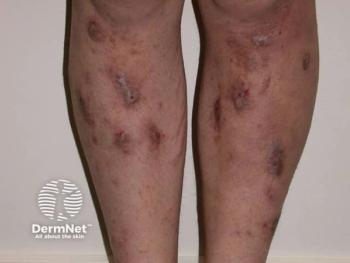
Coding 2017 and beyond
Recent Medicare changes include the apparent disappearance of consultation codes, the addition of site-specific soft-tissue excision codes, and increasing pressure from overseers and auditors, says an expert.
By following ongoing and sometimes subtle Medicare coding changes, says an expert at the Fall Clinical Dermatology Conference, dermatologists can maximize their income while avoiding overseers' crosshairs.
Vanishing codes?
In 2010, the Centers for Medicare & Medicaid Services (CMS) eliminated current procedural terminology (CPT) consultation codes, reasoning that they were actually new patient visits (to be coded with evaluation and management/E&M codes).
Dr. Coldiron"But they were not eliminated from the CPT codebook," says Brett Coldiron, M.D., associate professor of dermatology at the University of Cincinnati School of Medicine.
Most contracts with private insurers say that they will follow CPT coding convention, he added.
"This means you can still bill consultations to your private-insurance patients, which could be 70% to 80% of your practice." Not only do consultation codes pay more, but using them means "you can do the consultation, give your opinion and set these patients free – they're not considered an established patient when they come back within a year or two."
The National Correct Coding Initiative targets codes in the integumentary section, Dr. Coldiron says. In particular, he says, the – 25 modifier tells insurers that if one performs an examination, makes a diagnosis and performs a biopsy and a destructive procedure at the same visit, the dermatologist should get paid for both procedures.
However, he says, some insurers (led by Tufts and Harvard Pilgrim) arbitrarily decided to cut the visit code reimbursement 50% if a physician performs another service that day.
"That's incorrect. We're fighting that. Make sure that your contracts with Tufts and Harvard Pilgrim say they will follow current CPT coding convention, because then they can't ignore – 25." If your contract doesn't say this, says Dr. Coldiron, "Tell the patient 'we can't biopsy today,' and get paid in full for your service" when the patient returns, or drop the plan.
"Dermatologists are almost the only specialty that says, 'OK, we will drop everything and disrupt our schedule so we can do a procedure for you today.' Most specialists who do any sort of surgery have special days where they bring all the patients back for procedures. This is efficient from the physician’s point of view because everyone is set up for it. There's nothing wrong with behaving like other physicians do, particularly if insurers are going to penalize you for making care more convenient for their insureds."
Somewhat similarly, he says, the Medicare multiple-surgery reduction rule continues to plague dermatologists. Some insurers slash reimbursement for successive procedures performed at the same visit to 50%, then 25%, then to zero, he says.
"Watch out – always check the policy. You can have staff flag the chart." If performing a nonemergent procedure, "You shouldn't have to do the third one for free, or even the second. The patient can come back another day."
Trending down: upcoding
As always, adds Dr. Coldiron, be very cautious about upcoding.
"Even though your electronic medical record (EMR) says you can, you shouldn't be billing many Level 5 visits, and probably not many Level 4's – 97% of the E&M codes that dermatologists bill are Level 3 or lower." Acne follow-up visits, for example, do not require a total-body skin exam, he explains. But even if you "click enough buttons" in your EMR to raise the visit to an apparent Level 4 or 5, "You may have to down-code what your system tells you to do. It's very difficult to justify a Level 4 or 5 visit."
To measure a flap correctly, Dr. Coldiron explains, "Add the area underneath the flap plus the original hole – that's the total defect." Additionally, "It's OK to bill E&M codes with flap and graft codes, which have a 90-day global window, and with 0- to 10-day globals, if you use a – 57 modifier (decision for surgery)."
NEXT:
Several new codes specify soft-tissue excisions by site.
"Dermatologists can use these for lipomas, but not sebaceous cysts. They pay much better than benign excisions (zero days) and closures (10 days), which we've always done, because they have five follow-up visits built into their 90-day global period." These codes are not listed sequentially in the CPT book, he says, but rather scattered throughout the orthopedic section. "Make a note of them, so you know to type them into the EMR, because EMRs do not default to these. It's worthwhile to do it." The 21920 code for soft tissue biopsy of the back or flank pays 7.92 relative value units (RVU), for example, versus 3.13 RVU for a skin biopsy.
Ultimately, he says, CMS wants to eliminate global periods and payment for follow-up visits.
"It's ridiculous to make the patient pay additional co-pays and out-of-pocket to have stitches removed after you've sewn them up. Patients won't like that." CMS is planning a survey in nine states (Florida, Kentucky, Louisiana, Nevada, New Jersey, North Dakota, Ohio, Oregon and Rhode Island) to analyze how frequently dermatologists see patients in follow-up after codes with built-in global periods have been assigned, he says.
Starting July 1, 2017, groups of 10 or more will be required to report code 99024 when they see a patient in follow-up. Groups of fewer than 10 are encouraged to report, Dr. Coldiron says.
"Then CMS will decide whether to keep paying for embedded follow-up visits with certain codes such as excisions and destructions." He advised using 99024 whenever seeing a patient back, or basically doing anything after the initial visit. "Then we'll get credit for it in the survey."
Also under-recognized, says Dr. Coldiron, is the Medicare concept of unlikely edits.
"These are things that Medicare arbitrarily decided are impossible for doctors to do. They don't think you can do more than seven skin biopsies (add-on biopsy code 11101) in one day, for instance. I've seen patients for whom I had to do 13 skin biopsies in one day." If performing more than the somewhat arbitrary maximum number, he says, submit supporting documentation. "Otherwise it's going to get kicked out."
Additionally, "There's a lot of confusion about incident-to billing. Most of the time, if you're in the building and you've seen the patient and set up a treatment plan, the extender can bill 100% under the doctor's number. They often don't do that, because there's a misunderstanding." But extenders billing independently can only charge 85% of the doctor's fee. The most succinct explanation of this concept appears in the Office of the Inspector General (OIG) report,1 which lists the eight necessary conditions for incident-to billing, he says.
Increasing oversight
Under the Affordable Care Act, he says, dermatologists can expect more audits – by the OIG, Medicare's Comprehensive Error Rate Testing (CERT) program, zone program integrity contractors (ZPIC) and recovery audit contractors (RAC).
By the same token, says Dr. Coldiron, "Benchmarks are coming." Perhaps the furthest along is the Mohs layer ratio (first to subsequent layers, based on Medicare data from academic programs), which will be published by the American College of Mohs Surgery and Johns Hopkins School of Medicine's Choosing Wisely program, he says. "I believe that's going to be around 1.7, with a standard deviation up to 2.4." With this information, insurers can compare a surgeon's total first layers of the face, head and neck to the number of second and additional layers he or she performs. "Then we're going to monitor and see if the ratio decreases. There are some big outliers – people performing way too many layers that don't make sense."
The Medicare Learning Network publishes a newsletter called Medicare Learning Network Matters (
"It's been circulated to all the Medicare carriers," says Dr. Coldiron. The document stresses that physicians must submit highly detailed documentation, including histopathology, with Mohs operative notes – though this information may not be in local carrier directives. To avoid possible audits, "Be proactive about your Mohs documentation. You need a histopathologic description, even if it's clear on the first stage and completely out."
The Merit-based Incentive Payment System created by the Medicare Access and CHIP Reauthorization Act of 2015 (MACRA/MIPS), he adds, is "a bureaucratic nightmare. Bottom line, it's going to be easy to opt out the first year. Long-term, if you don't participate, MACRA is going to pay 90% of Medicare," or a 5% bonus for participating Advanced Alternative Payment Models (APMs) starting in 2019.
"Many people are going to say, 'no way.' This initiative is designed to favor primary care, large group practices and people who can automate their reporting. That's what the government wants: integrated care. And many dermatologists will never integrate – that's just the way it's going to be. Hopefully the change in administrations in Washington, D.C., will change some of this."
Disclosures: Dr. Coldiron reports no relevant financial interests
Reference
1. Office of Inspector General. Prevalence and qualifications of nonphysicians who performed Medicare physician services. Available at: https://oig.hhs.gov/oei/reports/oei-09-06-00430.pdf. August 2009. Accessed November 16, 2016.
Newsletter
Like what you’re reading? Subscribe to Dermatology Times for weekly updates on therapies, innovations, and real-world practice tips.


















